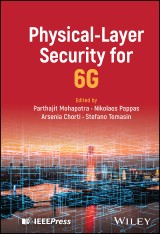Details

Physical-Layer Security for 6G
1. Aufl.
|
103,99 € |
|
| Verlag: | Wiley |
| Format: | EPUB |
| Veröffentl.: | 22.10.2024 |
| ISBN/EAN: | 9781394170937 |
| Sprache: | englisch |
| Anzahl Seiten: | 384 |
DRM-geschütztes eBook, Sie benötigen z.B. Adobe Digital Editions und eine Adobe ID zum Lesen.
Beschreibungen
<p><b>Meet the wireless security challenges of the future with this key volume</b> <p>The 6<sup>th</sup> generation of wireless communication technology—known as 6G—promises to bring both revolutionary advances and unique challenges. Secure communications will be harder than ever to achieve under the new integrated ground, air, and space networking paradigm, with increased connectivity creating the potential for increased vulnerability. Physical-layer security, which draws upon the physical properties of the channel or network to secure information, has emerged as a promising solution to these challenges. <p><i>Physical-Layer Security for 6G</i> provides a working introduction to these technologies and their burgeoning wireless applications. With particular attention to heterogeneous and distributed network scenarios, this book offers both the information-theory fundamentals and the most recent developments in physical-layer security. It constitutes an essential resource for meeting the unique security challenges of 6G. <p><i>Physical-Layer Security for 6G</i> readers will also find: <ul><li>Analysis of physical-layer security in the quality of security framework (QoSec)</li><li>Detailed discussion of physical-layer security applications in visible light communication (VLC), intelligence reflecting surface (IRS), and more</li><li>Practical use cases and demonstrations</li></ul> <p><i>Physical-Layer Security for 6G</i> is ideal for wireless research engineers as well as advanced graduate students in wireless technology.
<p><b>Parthajit Mohapatra, PhD,</b> is Associate Professor in the Department of Electrical Engineering, Indian Institute of Technology, India. His research focuses on physical-layer secrecy, short packet communication, union of networking & physical-layer techniques, and related areas. <p><b>Nikolaos Pappas, PhD,</b> is Associate Professor in the Department of Computer and Information Science, Linköping University, Sweden. His research concerns semantic wireless communications, network-level cooperative wireless networks, stochastic modeling, and related subjects. <p><b>Arsenia Chorti, PhD,</b> is Professor and Head of the Information, Communications and Imaging (ICI) Group of the ETIS Lab UMR8051, CY Cergy Paris Universite, France, and a Visiting Research Scholar at Princeton University, USA, and the University of Essex, UK. Her research focuses on physical-layer security, especially context-aware security, intrusion detection in IoT networks, and related subjects. <p><b>Stefano Tomasin, PhD,</b> is Professor at the University of Padova, Italy. His research concerns physical-layer security and signal processing for wireless communications, and he serves as Deputy EiC of the IEEE Transactions on Information Forensics and Security.
<p><b>Meet the wireless security challenges of the future with this key volume</b> <p>The 6<sup>th</sup> generation of wireless communication technology—known as 6G—promises to bring both revolutionary advances and unique challenges. Secure communications will be harder than ever to achieve under the new integrated ground, air, and space networking paradigm, with increased connectivity creating the potential for increased vulnerability. Physical-layer security, which draws upon the physical properties of the channel or network to secure information, has emerged as a promising solution to these challenges. <p><i>Physical-Layer Security for 6G</i> provides a working introduction to these technologies and their burgeoning wireless applications. With particular attention to heterogeneous and distributed network scenarios, this book offers both the information-theory fundamentals and the most recent developments in physical-layer security. It constitutes an essential resource for meeting the unique security challenges of 6G. <p><i>Physical-Layer Security for 6G</i> readers will also find: <ul><li>Analysis of physical-layer security in the quality of security framework (QoSec)</li><li>Detailed discussion of physical-layer security applications in visible light communication (VLC), intelligence reflecting surface (IRS), and more</li><li>Practical use cases and demonstrations</li></ul> <p><i>Physical-Layer Security for 6G</i> is ideal for wireless research engineers as well as advanced graduate students in wireless technology.
Diese Produkte könnten Sie auch interessieren:

6th International Conference on Ignition Systems for SI Engines - 7th International Conference on Knocking in SI Engines

von: Marc Sens, IAV GmbH IAV GmbH

151,99 €
















